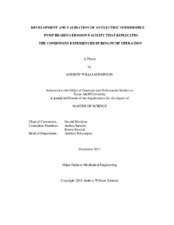| dc.description.abstract | The ever increasing global oil demand has forced the energy industry to provide artificial stimulation to many oil wells to increase their productivity. A common way to do this is to install an electric submersible pump (ESP) in the wellbore to overcome the pressure losses associated with bringing hydrocarbons to the surface for processing. This type of artificial lift has become increasingly more popular in offshore oil fields. When an ESP fails in a subsea well, the cost to replace it has been estimated to be as much as forty times the cost of the pump due to the high price of offshore rig time.
The increase in deep water oil production over the past two decades has demanded that ESPs operate properly for as long as possible. One of the most common failure modes for ESPs arises from erosion by sediments (fine sand) in the flow. The journal bearings in the ESP are susceptible to erosion from these particles because the pump bearings are lubricated by the fluid flowing through the pump. Previous ESP erosion tests that were conducted at the Turbomachinery Laboratory at Texas A&M University show that the erosion caused by sand particles in the flow lead to ESP journal bearing erosion that ultimately caused the pump to fail.
This work provides the design, construction, and validation of a testing apparatus that was built to replicate a single ESP stage so that journal bearings can be eroded and evaluated to be used to design new bearings with a longer lifetime. The testing apparatus is capable of replicating the conditions of an ESP to conduct erosion studies on a journal bearing independent of the actual pump. This provides a cost effective way to test different bearing materials over a variety of different operating conditions.
The testing apparatus is capable of operating speeds up to 7200 RPM, gas volume fractions (GVF) ranging from 0-100%, and different testing liquids (water or oil). The testing apparatus was designed to collect bearing annulus dynamic pressure, temperature, and the radial loads the bearing experiences as well as measure the orbital displacement of the bearing. In addition, the bearing geometry can be measured and the surface can be observed at discrete time intervals. | en |


